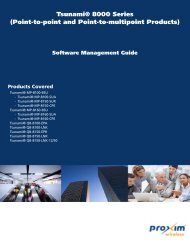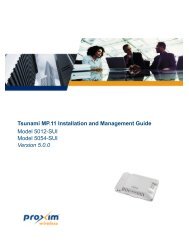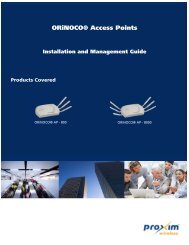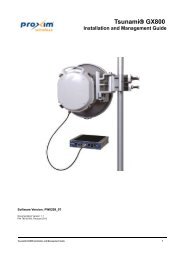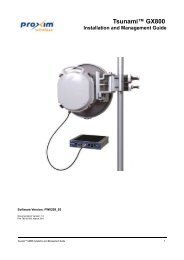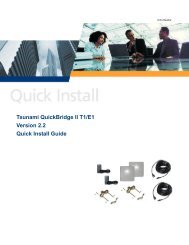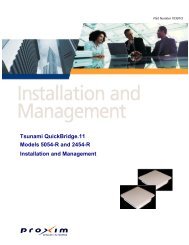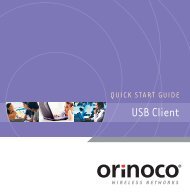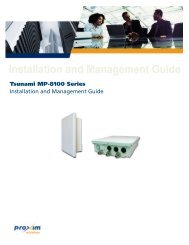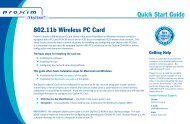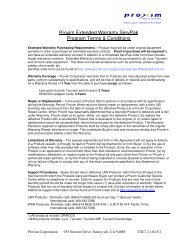Tsunami MP.11 Installation and Management Model 5012-SUR ...
Tsunami MP.11 Installation and Management Model 5012-SUR ...
Tsunami MP.11 Installation and Management Model 5012-SUR ...
Create successful ePaper yourself
Turn your PDF publications into a flip-book with our unique Google optimized e-Paper software.
Configuration <strong>Tsunami</strong> <strong>MP.11</strong> <strong>5012</strong>-<strong>SUR</strong> <strong>Installation</strong> <strong>and</strong> <strong>Management</strong><br />
Network Parameters<br />
retransmitted frames is greater than the slow scanning threshold given in percentage, the SU does not scan other<br />
channels for a better BSU.<br />
• The normal scanning procedure starts when the average local SNR for the current BSU is less than or equal to the<br />
slow scanning threshold <strong>and</strong> the number of retransmitted frames is greater than the slow scanning threshold given in<br />
percentage. During the normal scanning procedure the SU scans the whole list of active channels while maintaining<br />
the current session uninterrupted.<br />
• Fast scanning is the scanning procedure performed when the average local SNR for the current BSU is very low<br />
(below the fast scanning threshold) <strong>and</strong> the number of retransmitted frames is greater than the fast scanning<br />
retransmission threshold given in%, so that the current session should terminate as soon as possible. During this<br />
procedure, the SU scans other active channels as fast as possible.<br />
Roaming can only occur if the normal scanning or fast scanning procedure is started under the following conditions:<br />
1. If the roaming is started from the normal scanning procedure (after the SU scans all the active channels), the SU<br />
selects the BSU with the best SNR value on all available channels. The SU roams to the best BSU only if the SNR<br />
value for the current BSU is still below the slow scanning SNR threshold, <strong>and</strong> best BSU offers a better SNR value for<br />
at least roaming threshold than the current BSU. The SU starts a new registration procedure with the best BSU<br />
without ending the current session.<br />
2. If the roaming is started from the fast scanning procedure, the SU selects the first BSU that offers better SNR than the<br />
current BSU, <strong>and</strong> starts a new registration procedure with the better BSU without ending the current session.<br />
Roaming with Dynamic Data Rate Selection (DDRS) Enabled<br />
When an SU roams from BSU-1 to BSU-2 <strong>and</strong> DDRS is enabled, the data rate at which the SU connects to BSU-2 is the<br />
default DDRS data rate. If this remains at the factory default of 6 Mbps, there can be issues with the application if it<br />
requires more then 6 Mbps (for example multiple video streams).<br />
Applications requiring a higher data rate could experience a slight data loss during the roaming process while DDRS<br />
selects a higher rate (based upon link conditions).<br />
When the applications re-transmit at a possibly slower rate, the WORP protocol initially services the data at 6 Mbps <strong>and</strong><br />
increases the data rate up to the "Maximum DDRS Data Rate" (ddrsmaxdatarate) one step at a time. Because the<br />
applications are not being serviced at the best possible rate, they further slow down the rate of data send.<br />
The DDRS algorithm requires data traffic (a minimum of 128 frames) to raise the rate to a higher value. Although roaming<br />
occurs successfully, the previous scenario causes applications to drop their sessions; hence session persistence is not<br />
maintained.<br />
For a more information on DDRS, see Dynamic Data Rate Selection (DDRS).<br />
NOTE: You must know the data rate required for the applications running <strong>and</strong> you must ensure (during network<br />
deployment) that the ranges <strong>and</strong> RF links can support the necessary data rate. You also must set the default<br />
DDRS data rate at the capacity necessary for the application so that it connects to the next Base Station at the<br />
required capacity if roaming occurs. Set the “Default DDRS Data Rate” (ddrsdefdatarate) to a greater value (24,<br />
36, 48 or 54 Mbps, for example) for applications requiring session persistence when roaming occurs.<br />
Roaming Configuration<br />
Click Configure > Network > Roaming to configure Roaming.<br />
Enable or disable the Roaming feature in the Roaming Status drop-down box. The default value is disabled.<br />
63





